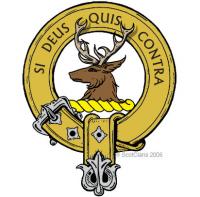
Clan Spens
It is believed that the surname Spens, or Spence, may have derived from the Old French word for ‘custodian’ or ‘dispenser’. The principal line of the Clan Spens family are descendents of one of the ancient Earls of Fife.
In the 13th and 14th centuries a number of people with the name Spens were recorded in various papers. In 1232 a Roger ‘dispensator’ was recorded as having been witness to a deed documenting the transfer of lands near Dallas in Inverness-shire, and in Irvine, a John Spens was a baillie of the town in 1260. There was a Henry de Spens of Lathallan who died in 1300, and a Henry Spens who, in 1390, was witness to a charter made by Robert, Earl of Fife. Henry de Spens of Lathallan died on four years after putting his name to the Ragman Rolls pledging his allegiance to England’s Edward I along with numerous other Scottish nobles. His son Thomas was mentioned in at least two charters by King Robert the Bruce. In 1430 the family’s lands were made into a barony.
By the 15th century, the Spens clan had gained a certain amount of prominence, and when James I called a parliament at Perth in 1434, John Spens of Lathallan was granted a seat. John married Isabel Wemyss, daughter of Sir John Wemyss and the couple had three sons. The youngest, called Patrick, was a soldier and a member of the Guard of Scots, Archers. In 1450 the archers were sent by James II under the command of Patrick to France to help Charles VII, and Patrick ended up settling there. It is from him that the prominent Spens-Destinot de Lanere family descend. The company of archers were later known as the ‘Garde Ecossaise’, and were the personal bodyguards to the French monarchs until 1791 when they were disbanded during the revolution.
The second son of John and Isabel, Thomas, born in 1415, went into the church, where he did well and rose to high office. Thomas was made Bishop of Galloway around 1450 and then seven years later became Aberdeen’s bishop. He was seen as being a clever man and a shrewd negotiator. He was regularly employed on state business, and was appointed Lord Privy Seal on two occasions: the first between 1458 and ‘59 and the second from 1467 to 1470. Thomas was given the job of concluding the marriage contract between Louis of Savoy, Count of Geneva and the younger sister of James II, Annabella. Two years later, in 1451, he was sent to England as an ambassador of the Scottish crown to try and negotiate a truce with the English. On the 14th of April, 1480, Thomas died, and he was buried at Roslin chapel.
The Spens clan were divided in opinion over Mary, Queen of Scots. John Spens, Lord Condie was the Lord Advocate in 1561 and was told by Mary to prosecute the religious reformer John Knox for alleged treason. Spens did so, but with no real enthusiasm or effort and Knox was acquitted. However, David Spens of Wormieston was a strong supporter of the queen and was labelled as a rebel by the Parliament that the Regent Lennox called in the August of 1571. The following month there was a plot to kidnap Lennox, and David was one of the ringleaders. His job was to personally hold the regent. It is said that Spens took his job of keeping Lennox secure so literally that when it was decided to kill him Spens threw himself in front of Lennox to prevent the prisoner from being shot. Unfortunately for David Spens, when Lennox’s rescuers arrived he was killed on the spot, even though Lennox tried to save him. During the reign of James VI, the Spens’ of Wormieston were in favour with the royal court and Sir James Spens was sent as Scottish ambassador to Sweden. A branch of the family settled there and rose high in the Swedish nobility as Counts Spens.
The Craigsanquhar estate in Fife belonged to the Spens family between 1385 and 1524, and was bought back in 1792 by the second son of the 15th Laird of Lathallan, Dr Nathaniel Spens (1728-1815). In 1794 Dr Spens was the president of the Royal College of Physicians, and he was also a prominent member of the Royal Company of Archers (the bodyguards to the monarchs in Scotland). There is a portrait of him that hangs in Archers’ Hall in Edinburgh. One of his descendents, Sir Patrick Spens (1885-1973), was made 1st Lord Spens of Blairsanquhar in 1959. Other descendents of Nathaniel include Sir William Spens, a vice-chancellor of the University of Cambridge between 1931 and 1933, and John Alexander Spens Esq, MVO, RD, WS, who was appointed Albany Herald of Arms in 1985.







